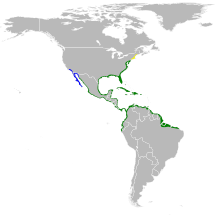| Tricolored heron | |
|---|---|

| |
| Egretta tricolor in Quintana, Texas | |
| Conservation status | |
 Least Concern (IUCN 3.1) | |
| Scientific classification | |
| Domain: | Eukaryota |
| Kingdom: | Animalia |
| Phylum: | Chordata |
| Class: | Aves |
| Order: | Pelecaniformes |
| Family: | Ardeidae |
| Genus: | Egretta |
| Species: | E. tricolor |
| Binomial name | |
| Egretta tricolor (Müller, 1776) | |

| |
| Range of E. tricolor Breeding range Year-round range Wintering range | |
| Synonyms | |
| |
The tricolored heron (Egretta tricolor), formerly known as the Louisiana heron, is a small species of heron native to coastal parts of the Americas. The species is more solitary than other species of heron in the Americas and eats a diet consisting mostly of small fish.
Habitat, breeding, and distribution
Tricolored herons breed in swamps and other coastal habitats and nests in colonies, often with other herons, usually on platforms of sticks in trees or shrubs. In each clutch, three to seven eggs are typically laid. The tricolored heron is the second most coastal heron in the United States.
The species' range follows the northeastern United States, south along the coast, through the Gulf of Mexico and the Caribbean, to northern South America as far south as Brazil. In the Pacific region, it ranges from Peru to California, but it is only a nonbreeding visitor to the far north.
It was likely the most numerous heron in North America until the cattle egret arrived to the continent in the 1950s. While the species' population appears to be on the decline, it remains quite common. The bird is listed as "Threatened" by the Florida Fish and Wildlife Conservation Commission.
Description
This species measures from 56 to 76 cm (22 to 30 in) long and has a typical wingspan of 96 cm (38 in). The slightly larger male heron weighs 415 g (14.6 oz) on average, while the female averages 334 g (11.8 oz). It is a medium-large, long-legged, long-necked heron with a long, pointed, yellowish or greyish bill with a black tip. Its legs and feet are dark. The plumage of the triclolored heron changes dramatically from its juvenile form to its adult form.
Adults have a blue-grey head, neck, back, and upper wings, with a white line along the neck. The belly is white. In breeding plumage, they have long, blue, filamentous plumes on their heads and necks, and buff ones on their backs.
Behavior and diet
The tricolored heron is more solitary when foraging than other North American herons. When it forages for its prey, it is typically belly-deep in water, alone or at the edge of a mixed flock. Kent (1986) found that the diets of tricolored herons in Florida consisted of 99.7% fish and prawns. While other members of Egretta may also eat crabs and opportunistically forage for terrestrial arthropods, the tricolored heron has been consistently observed to be almost exclusively piscivorous, primarily feeding on members of Cyprinodontidae, Fundulidae and Poeciliidae, as well as Centropomidae and Cichlidae.
Gallery
-
 Feeding
Feeding
-
 Marco Island, Florida
Marco Island, Florida
-
-
 Flying
Flying
-
 Juvenile
Juvenile
-

-
 In full breeding colors in central Florida
In full breeding colors in central Florida
-
 Between the crocodiles Tortuguero, Costa Rica
Between the crocodiles Tortuguero, Costa Rica
References
- BirdLife International (2016). "Egretta tricolor". IUCN Red List of Threatened Species. 2016: e.T22696931A93594077. doi:10.2305/IUCN.UK.2016-3.RLTS.T22696931A93594077.en. Retrieved 11 November 2021.
- "Egretta tricolor (Statius Muller, 1776)". Global Biodiversity Information Facility. Retrieved 25 March 2023.
- ^ Frederick, Peter C. (2020). Poole, A.F. (ed.). "Tricolored Heron (Egretta tricolor), version 1.0". Birds of the World. Ithaca, New York: Cornell Lab of Ornithology. doi:10.2173/bow.triher.01.
- ^ "Tricolored Heron". Audubon. 2014-11-13. Retrieved 2022-12-31.
- ^ "The Tricolored Heron Has More Than Three Colors". Audubon Florida. 2019-07-15. Retrieved 2022-12-31.
- "Tricolored Heron". All About Birds. Cornell Lab of Ornithology.
- "Biological and Ecotoxicological Characteristics of Terrestrial Vertebrate Species Residing in Estuaries: Tricolored Heron". USGS.
- Kent, Donald M. (1986). "Behavior, Habitat Use, and Food of Three Egrets in a Marine Habitat". Colonial Waterbirds. 9 (1): 25–30. doi:10.2307/1521140. JSTOR 1521140.
- Miranda, Leopoldo; Collazo, Jaime A (1997). "Food Habits of 4 Species of Wading Birds (Ardeidae) in a Tropical Mangrove Swamp". Colonial Waterbirds. 20 (3): 413–418. doi:10.2307/1521591. JSTOR 1521591.
Further reading
- Hilty, Steven L. (2003). Birds of Venezuela. Princeton University Press. ISBN 0-7136-6418-5.
- Field Guide to the Birds of North America. National Geographic. 1987. ISBN 0-7922-6877-6.
- Stiles, F. Gary; Skutch, Alexander F. (1989). A Guide to the Birds of Costa Rica. Comstock Publishing Associates. ISBN 0-8014-9600-4.
External links
- Tricolored Heron - Egretta tricolor - USGS Patuxent Bird Identification InfoCenter
- Tricolored heron photos at Field Guide: Birds of the World on Flickr
- Tricolored heron Bird Sound at Florida Museum of Natural History
- "Tricolored heron media". Internet Bird Collection.
- Tricolored heron photo gallery at VIREO (Drexel University)
- Tricolored Heron species account at Neotropical Birds (Cornell Lab of Ornithology) (subscription required)
- IUCN Red List least concern species
- Egretta
- Birds of the Americas
- Birds of the Caribbean
- Birds of the Guiana Shield
- Birds of Mexico
- Birds of Panama
- Birds of Colombia
- Birds of Venezuela
- Birds of Ecuador
- Birds of Peru
- Birds of Brazil
- Native birds of the Southeastern United States
- Birds described in 1776
- Taxa named by Philipp Ludwig Statius Müller
